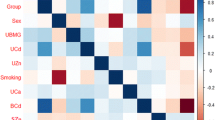Abstract
Cadmium, copper and zinc have been determined in kidney cortex, kidney medulla and liver from 51 cadmium-polluted and 122 nonpolluted autopsied subjects. Liver cadmium and zinc were significantly higher in the cadmium-polluted subjects than in the nonpolluted subjects. Kidney cadmium, copper and zinc were lower in the cadmium-polluted subjects because of renal damage. Significant correlations of the three metals were found in the kidney. In the liver the correlation coefficients were significant only between cadmium and zinc.
Similar content being viewed by others
References
Bremner I (1979) Mammalian absorption transport and excretion of cadmium. In: Webb M (ed) The chemistry, biochemistry and biology of cadmium. Elsevier North-Holland Biomedical Press, Amsterdam, New York, Oxford pp 175–193
Bremner I, Campbell JK (1978) Effect of copper and zinc status on susceptibility to cadmium intoxication. Environ Health Perspect 25: 125–128
Bremner I, Davies NT (1975) The induction of metallothionein in rat liver by zinc injection and restriction of food intake. Biochem J 149: 733–738
Bremner I, Marshall RB (1974) Hepatic copper- and zinc-binding proteins in ruminants. 2. Relationship between Cu and Zn concentrations and the occurrence of a metallothionein-like fraction. Br J Nutr 32: 293–300
Bunn CR, Matrone G (1966) In vivo interactions of cadmium, copper, zinc and iron in the mouse and rat. J Nutr 90: 395–399
Campbell JK, Mills CF (1974) Effects of dietary cadmium and zinc on rats maintained on diets low in copper. Proc Nutr Soc 33: 15A
Elinder CG, Piscator M (1977) Cadmium and zinc relationships in kidney cortex, liver, and pancreas. Environ Res 13: 432–440
Elinder CG, Piscator M (1978) Cadmium and zinc relationships. Environ Health Perspect 25: 129–132
Gunn SA, Gould TC, Anderson WAD (1961) Zinc protection against cadmium injury to rat testis. Arch Pathol 71: 274–281
Gunn SA, Gould TC, Anderson WAD (1963) The selective injurious response of testicular and epididymal blood vessels to cadmium and its prevention by zinc. Am J Pathol 42: 685–695
Ishizaki A, Fukushima M, Sakamoto M (1971) Contents of cadmium and zinc in organs of itai-itai disease patients and residents of Hokuriku District. Jpn J Hyg 26: 268–273
Iwao S, Tsuchiya K, Sugita M (1983) Variation of cadmium accumulation among Japanese. Arch Environ Health 38: 156–162
Jacobs RM, Spivey Fox MR, Lee Jones AD, Hamilton RP, Lener J (1977) Cd metabolism: Individual effects of Zn, Cu, and Mn. Fed Proc 36: 1152
Kägi JHR, Vallee BL (1960) Metallothionein: A cadmium- and zinc-containing protein from equine renal cortex. J Biol Chem 235: 3460–3465
Kägi JHR, Vallee BL (1961) Metallothionein: A cadmium- and zinc-containing protein from equine renal cortex. II. Physicochemical properties. J Biol Chem 236: 2435–2442
Kawano S, Omura T, Nakagawa H, Toga H, Nishi M, Matsuo Y (1980) Relationship between renal tubular damage and urinary excretion of heavy metals. Kankyo Hoken Report. 46: 248–255 (in Japanese)
Kimura M, Otaki N, Yoshiki S, Suzuki M, Horiuchi N, Suda T (1974) The isolation of metallothionein and its protective role in cadmium poisoning. Arch Biochem Biophys 165: 340–348
Kobayashi S (1983) Effect of aging on the concentration of cadmium, zinc and copper in human kidney. Jpn J Publ Hlth 30: 27–34
Magos L, Webb M (1978) Theorectical and practical considerations on the problem of metal-metal interaction. Environ Health Perspect 25: 151–154
Merali Z, Singhai RL (1976) Prevention by zinc of cadmium-induced alterations in pancreatic and hepatic functions. Br J Pharmacol 57: 573–579
Nogawa K, Yamada Y, Honda R, Tsuritani I, Kobayashi E Ishizaki A (1984) Copper and zinc levels in serum and urine of cadmium-exposed people with special reference to renal tubular damage. Environ Res 33: 29–38
Nordberg M, Elinder CG, Rahnster B (1979) Cadmium, zinc and copper in horse kidney metallothionein. Environ Res 20: 341–350
Pařízek J (1957) The destructive effect of cadmium ion on testicular tissue and its prevention by zinc. J Endocrinol 15: 56–63
Petering HG, Johnson MA, Stemmer KL (1971) Studies of zinc metabolism in the rat. Arch Environ Health 23: 93–101
Piscator M, Lind B (1972) Cadmium, zinc, copper, and lead in human renal cortex. Arch Environ Health 24: 426–431
Roberts KR, Miller WJ, Stake PE, Gentry RP, Neathery MW (1973) High dietary cadmium on zinc absorption and metabolism in calves fed for comparable nitrogen balances. Proc Soc Exp Biol Med 144: 906–908
Schroeder HA, Nason AP, Tipton IH, Balassa JJ (1966) Essential trace metals in man: copper. J Chronic Dis 19: 1007–1034
Sumino K, Hayakawa K, Shibata T, Kitagawa S (1975) Heavy metals in normal Japanese tissues. Arch Environ Health 30: 487–494
Task Group on Metal Interaction (1978) Factors influencing metabolism and toxicity of metals: A consensus report. Nordberg GF (ed) Environ Health Perspect 25: 3–41
Teraoka H (1981) Distribution of 24 elements in the internal organs of normal males and the metallic workers in Japan. Arch Environ Health 36: 155–165
Tsuchiya K, Iwao S (1978) Interrelationships among zinc, copper, lead and cadmium in food, feces, and organs of humans. Environ Health Perspect 25: 119–124
Webb M (1972a) Binding of cadmium ions by rat liver and kidney. Biochem Pharmacol 21: 2751–2765
Webb M (1972b) Protection by zinc against cadmium Toxicity. Biochem Pharmacol 21: 2767–2771
Webb M, Verschoyle RD (1976) An investigation of the role of metallothioneins in protection against the acute toxicity of the cadmium ion. Biochem Pharmacol 25: 673–679
Yukawa M, Amano K, Suzuki-Yasumoto M, Terai M (1980) Distribution of trace elements in the human body determined by neutron activation analysis. Arch Environ Health 35: 36–44
Author information
Authors and Affiliations
Rights and permissions
About this article
Cite this article
Honda, R., Nogawa, K. Cadmium, zinc and copper relationships in kidney and liver of humans exposed to environmental cadmium. Arch Toxicol 59, 437–442 (1987). https://doi.org/10.1007/BF00316211
Received:
Accepted:
Issue Date:
DOI: https://doi.org/10.1007/BF00316211




